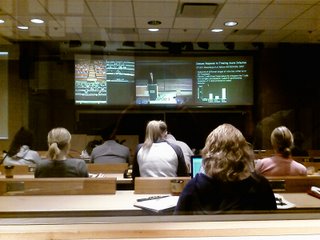We've moved
We're waiting no longer. We have moved our activity over to our own blog engine.
https://normedlive.lakeheadu.ca/cs/blogs/nosmeld/
This also allows us to put some control on the spam comments.
We hope you'll continue to follow us there.
Northern Ontario School of Medicine eLearning Discussions. A trial site to explore the use of blogs for the school. Check out www.normed.ca for more information about the school itself.
We're waiting no longer. We have moved our activity over to our own blog engine.
Hmm, I'm not a happy blogger at the moment. Google has unhelpfully updated its blogger engine. So far I cannot see any benefit from this. Seems slower than before and I have not found any improved features.
Computer scientist reveals the math and science behind blockbuster movies
OpenID: an actually distributed identity system
The Most Annoying Things About Windows Vista
Surgeons who play video games more skilled - CNN.com
Another approach to improve our interaction with computers.
Sounds fascinating, although not to be categorised under Coming Soon, I don't think.
This short discussion is awfully reminiscent of such famous quotes as...
Link to Hindsight is 20/20 | jon lee dot see eh
"The world only has a need for about 6 computers" [Thomas Watson, IBM] and "640k should be enough for anybody' [Bill Gates].
Ah, those that fail to appreciate the effects of exponential trends. Sigh. Ray Kurzweil writes extensively about this in his books - our tendency to use linear extrapolation based on current activity and data.
Well, not quite...actually, not by a long shot...
Link to Pocket PC Thoughts - Daily News, Views, Rants and Raves
...but this is Microsoft's latest version of their operating system for Windows Mobile devices. It will not likely be available until June - it takes a while for manufacturers to incorporate it into their ROMs on their devices and test it out for stability.
And as with most things Microsoft, just like with Vista, you probably don't want to be one of the early adopters.
So what do you think of the new ribbon in Microsoft Word 2007?
Link to Adaptive user interfaces for focused attention « Jon Udell
Adaptive interfaces are definitely a good idea. Military fighter jets first took up this idea - keep the interface simple. Humans are not good at simultaneously monitoring hundreds of dials and flashing lights.
But what about the new Office 2007 interface? Jon seems to feel it is a good idea, as have some other writers. But for users who have gotten used to menu items being in a certain place, there is some new learning required.
I expect the Gates empire will find a way to enforce us all to upgrade at one point or another. The Borg Collective will assimilate...
This was put out last week. Has anyone tried any of these search engines? I have tried a few but have to admit, I had not heard of some of them.
We've had some experience with this software...
HandShake is a nice easy haptics tool to do rapid prototyping with. This is one of the tools that we have been using in our Virtual Spinal Tap project.
Thanks to Kevin Pashuk for sending us this link. Always good working with you, Kevin.
Paper is dead - has PDF followed suit?
Because of some recent confusion over the possible meanings of words like 'desktop' when used in relation to personal videoconferencing, we were asked to come up with a simple glossary. This was originally created as a Word doc but is reproduced here. Within the glossary are also embedded some tips relating to desktop or personal videoconferencing.
Last week, the Director of Technology Pasi Pinta, and I took a trip out west to see things are going at the UBC Northern Medical Program. Based in Prince George, this new program is similar in concept to NOSM - community based, rural oriented, focused on the needs of the north. They started a year before us and are similar in many ways.

Last week I was at the Ontario Library Association Conference. While there I had the opportunity to attend a presentation by Michael Stephens titled: “Best Practices for Social Software”. He also did a presentation on “Top Tech Trends”. Links to both presentations are available on his blog – Tame the Web and worth having a look at.
| Who needs Virtual Reality if you can get robotics to do this? A car seat with a 5 point racing harness welded to a robotic arm. This is a crazy, but fun ride. And the relevane of this to eLearning - just an example of using very short videos to make a point, as we are doing with PocketSnips (www.pocketsnips.org) | |
Well, not quite...
Link to A robot gives birth at Unbounded Medicine
But a short piece on the use of simulators to teach labour and delivery techniques.